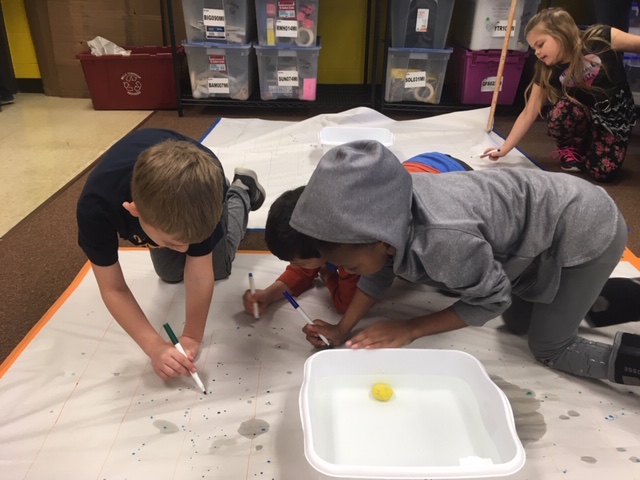Youth are discovering science in the Alcona 4-H Makerspace
First graders explored answers to the question “why does poop splash?”

Teaching science can be intimidating, but it doesn’t have to be. There are discoveries to be made every day, in some of the most unexpected places. Michigan State University Extension and 4-H volunteers used a “Teaching Science When You Don’t Know Diddly-squat” activity to engage Alcona County first graders in the Alcona 4-H Makerspace. The first graders explored their answers to the question: why does poop splash?
Have you ever noticed that when you go to the bathroom sometimes the poop splashes your backside when it hits the water? The Alcona first graders did, and after a serious discussion, identified three factors they thought could change how much water hit their backside.
- The size of the poop
- The shape of the poop
- The distance the poop fell into the water
Before beginning the exploration, the youth discussed what they thought would happen.
- They all thought bigger balls of clay, or “poop,” would make bigger splashes.
- There were many ideas about how much splash different shapes would make.
- The majority thought the higher the poop was from the water when dropped, the bigger the splash it would make.
To begin the experiment, the youth were split into three groups each exploring a different factor they had identified. To level the playing field, all three groups were given a 100-gram ball of clay, yardstick and basin of water. 4-H volunteers helped setup newsprint paper around each “toilet,” which were basins of water with incremental rings (think bullseye target), so that the youth could easily see and count the number of splashes after each drop.
The youth used a marker to mark and count the splashes. They also collected the weight, shape and distance from the water for each trial. Remember that only one factor was changing in each group. The information collected in a data table was used to compare to their original thoughts about what would happen.
After completing the experiment, the first graders were able to explain how each factor could change how much water splashed. They discovered:
- Bigger balls did make bigger splashes.
- Skinnier, log-like shapes made smaller splashes.
- The higher the clay was from the water, the farther the water splashed.
|
Sample data table: Number of splashes |
|||||
|
Weight or shape |
Distance above the water |
# of drops between 0-5 inches from bucket |
# of drops between 5-10 inches from bucket |
# of drops between 10-15 inches from bucket |
# of drops between 15-20 inches from bucket |
The learning didn’t stop there. One of the most crucial steps to discovery is the wrap-up discussion. This provides an opportunity to talk about what happened, why they think it happened and what they might want to try next. Remember, science isn’t about knowing all the answers, it’s about being curious enough to ask questions.

During the wrap-up discussion, the first graders discussed:
- Why people are not comfortable talking about poop.
- What and who poops?
- Why do animals and people need to poop?
- Are there people who study poop?
- What could be important for people to study poop?
The goal of Michigan State University Extension and the Alcona 4-H Makerspace is to increase interest and awareness in STEM (Science Technology Engineering and Mathematics). The “Teaching Science When You Don’t Know Diddly-squat: Why Does Poop Splash” activity captured the interest of the Alcona first graders while engaging them in the process of science.
Michigan State University Extension and the Michigan 4-H Youth Development program help to create a community excited about STEM (Science, Technology, Engineering, and Mathematics). 4-H STEM programming seeks to increase science literacy, introducing youth to the experiential learning process that helps them to build problem-solving, critical-thinking and decision-making skills. Youth who participate in 4-H STEM are better equipped with critical life skills necessary for future success.
To learn more about the positive impact of Michigan 4-H youth in STEM literacy programs, read our 2017 Impact Report: “Equipping Young People for Success Through Science Literacy.”
To learn more about MSU Extension, visit the MSU Extension website. To learn more about 4-H and Extension opportunities in Alcona County, stop by our Harrisville office at 320 S. State St. Harrisville, MI 48740, or visit us online at our Alcona County MSU Extension Facebook page, Alcona County Extension office or Alcona 4-H Makerspace page.



 Print
Print Email
Email



